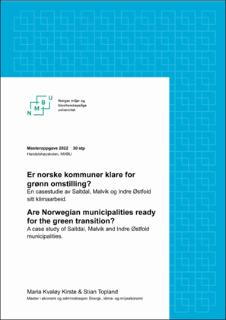| dc.contributor.advisor | Rosendahl, Knut Einar | |
| dc.contributor.author | Topland, Stian | |
| dc.contributor.author | Kirste, Maria Karoline Kvaløy | |
| dc.coverage.spatial | Norway | en_US |
| dc.date.accessioned | 2022-07-12T09:57:56Z | |
| dc.date.available | 2022-07-12T09:57:56Z | |
| dc.date.issued | 2022 | |
| dc.identifier.uri | https://hdl.handle.net/11250/3004640 | |
| dc.description.abstract | Klimaendringene er et globalt problem som må løses gjennom internasjonalt samarbeid, med nasjonal innsats og konkrete tiltak lokalt. Som en del av den globale Paris-avtalen er Norges nasjonale klimamål for 2030 50-55% utslippsreduksjon sammenlignet med 1990 nivåer. Norske kommuner har en sentral rolle for å klare dette, både som samfunnsutvikler, myndighetsutøver, innkjøper, eier og drifter av tiltak, samt pådriver i lokalsamfunnet for grønn omstilling.
Klimapolitiske verktøy for å redusere klimagassutslipp består både av regulerende og markedsbaserte verktøy som gir insentiv til adferdsendring. Det viktigste verktøyet den norske regjeringen har implementert for å oppnå mest kostnadseffektiv reduksjon, er det markedsbaserte verktøyet CO2-avgift. Denne er bestemt at gradvis skal øke fra dagens 760 kr til 2 000 kr innen 2030. Problemstillingen for denne oppgaven er derfor: Hvordan jobber norske kommuner med å redusere utslipp fra egen drift frem mot en økt CO2-avgift i 2030?
For å få bedre innsikt og forståelse for hvordan norske kommuner arbeider med å nå klimamålene sine, har vi i denne oppgaven valgt en kvalitativ tilnærming med bruk av casestudie av tre norske kommuner; Saltdal, Malvik og Indre Østfold. Oppgaven baserer seg på tall fra sekundærkilder, med utfyllende informasjon fra gjennomførte dybdeintervju med kommunerepresentanter. De mest sentrale sekundærkildene er kommunenes klimaregnskap utformet ved klimakostmetoden basert på KOSTRA-rapportering, og klimabudsjett utarbeidet av kommunene selv.
Ved å anslå deres fremtidige utslipp målt opp mot klimamålene deres har vi avdekket at de tre kommunene ikke ligger an til å nå klimamålene sine, med dagens vedtatte klimatiltak. Hovedutfordringer vi har sett, er mangel på ressurser, politisk prioritering av klimatiltak, små stillingsprosenter bevilget klimaarbeid og manglende innsikt om kostnadseffektive klimatiltak. Kommunene virker ikke bevisste egne investeringskostnader knyttet til klimatiltak og CO2-avgiften. Dette mener vi tyder på at regjeringens opptrappingsplan av avgiften, ikke er høy nok alene. Det trengs flere nasjonale tiltak enn økt CO2-avgift for å oppnå ønsket utslippsreduksjon, i tillegg til at kommunene må ta mer ansvar for reduksjon av eget utslipp. | en_US |
| dc.description.abstract | Climate change is a global problem which requires international governance and cooperation, with national contribution and specific measures at local level. As part of the global Paris agreement, Norway has pledged to reduce their domestic emissions in 2030 by 50- 55% compared to 1990 levels. Norwegian municipalities have a central role to achieve this, both as a community developer, government official, purchaser, owner and operator of measures, as well as driving in the local community for a green transition.
Climate policy tools to reduce greenhouse gas emissions consist of both regulations and market based instruments which nudges behavior in the desired direction. The most important measure the Norwegian government has introduced to achieve cost effective emission reduction is the market based tool; CO2-tax. It's decided that the tax will gradually increase from today's 760 NOK to 2 000 NOK within 2030. Our issue for this task is therefore: How are Norwegian municipalities working with reducing emissions from their own operation towards an increased CO2-tax in 2030?
To increase the insight and understanding of how Norwegian municipalities work towards reaching their climate goals, we have in this task chosen a qualitative approach with the use of a case study where we look at three municipalities; Saltdal, Malvik and Indre Østfold. The thesis is based on numbers from secondary sources, with supplementary information from conducted in-depth interviews with municipal representatives. The most central secondary sources are the municipalities climate accounts designed by Klimakost method, based on numbers from KOSTRA reports, and climate budgets prepared by the municipalities themselves.
When estimating and comparing future emissions based on adopted measures with their climate goals, we uncovered that our chosen municipalities are not capable of achieving their climate goals. The main challenges we have discovered are lack of resources, political prioritizing of climate measures, small percentage of working positions dedicated to climate work and reduced insight about cost-effective climate measures. The municipalities do not seem aware of their own costs of investments regarding climate measures and the CO2-tax. We believe this implies that the planned escalation the government has decided regarding the CO2-tax, is too small as the only measure. More national measures than an increased CO2-tax are needed to achieve the desired emission reduction, in addition the municipalities have to take more responsibility for reduction of their own emissions. | en_US |
| dc.language.iso | nob | en_US |
| dc.publisher | Norwegian University of Life Sciences, Ås | en_US |
| dc.rights | Attribution-NonCommercial-NoDerivatives 4.0 Internasjonal | * |
| dc.rights.uri | http://creativecommons.org/licenses/by-nc-nd/4.0/deed.no | * |
| dc.title | Er norske kommuner klare for grønn omstilling? : en casestudie av Saltdal, Malvik og Indre Østfold sitt klimaarbeid | en_US |
| dc.title.alternative | Are Norwegian municipalities ready for the green transition? : a case study of Saltdal, Malvik and Indre Østfold municipalities | en_US |
| dc.type | Master thesis | en_US |
| dc.description.version | submittedVersion | en_US |
| dc.description.localcode | M-ØA | en_US |

